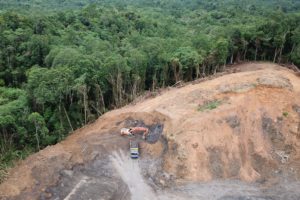Wildlife populations plummet as human population nears 8 billion
Written by Olivia Nater | Published: October 17, 2022
A new report reveals monitored populations of wild mammals, fish, reptiles, birds and amphibians have declined by an average of 69% over nearly 50 years, while conservation efforts have failed to tackle the root causes of biodiversity loss.
The Living Planet Report, published by the World Wide Fund for Nature (WWF) every two years, is a comprehensive analysis of trends in global biodiversity and the health of our planet. This year’s report, co-authored by 89 researchers, shows that despite three decades of conservation interventions, biodiversity loss continues unabated.
Compared to the 2020 edition (which showed a 68% decline between 1970 and 2016), the dataset for the 2022 report includes 838 additional species and 11,011 new populations, bringing the total to 5,230 species and almost 32,000 populations. The new report estimates a 69% decrease in wild vertebrate populations from 1970 to 2018. It notes that during that time, the human population doubled (from 3.7 billion to 7.6 billion), while the global economy grew nearly fourfold and global trade expanded tenfold.
Differences between regions and species
The worst affected geographic region is Latin America and the Caribbean, with a staggering 94% drop in wild vertebrate populations over five decades, followed by Africa (66%), Asia-Pacific (55%), North America (20%), and Europe and Central Asia (18%).
 The large decline in Latin America is largely attributed to deforestation, especially of the Amazon rainforest, a biodiversity hotspot. Deforestation rates are increasing, and currently around 10 million hectares of forest are cleared globally every year—an area equivalent to the size of Portugal or Indiana.
The large decline in Latin America is largely attributed to deforestation, especially of the Amazon rainforest, a biodiversity hotspot. Deforestation rates are increasing, and currently around 10 million hectares of forest are cleared globally every year—an area equivalent to the size of Portugal or Indiana.
Agriculture is the primary driver of deforestation and other habitat loss, using 50% of all habitable land. Expanding human populations, farmland and infrastructure are also causing severe habitat fragmentation, making it more difficult for wild animals to move between areas and increasing their risk of extinction. Only 10% of the world’s terrestrial protected areas are connected, and two-thirds of important areas linking protected areas have no protections whatsoever.
Freshwater animals have suffered the worst, with monitored populations having dropped by an average of 83% since 1970. More than half of the human population lives within 3 km (1.9 miles) of freshwater bodies, which are heavily impacted by water overextraction, artificial damming and diversion, overfishing, and pollution. Many freshwater species have to migrate to complete their lifecycle, but they often encounter barriers, with only 37% of rivers longer than 1,000 km (600 miles) remaining free-flowing along their entire length.
A growing threat: climate change
The report suggests that while habitat destruction and overexploitation of species (such as overfishing and hunting) are still by far the biggest causes of biodiversity loss, climate change may soon become the dominant threat if we fail to uphold the Paris Agreement of limiting warming to less than 2°C, and “preferably” 1.5°C.
Some recent species extinctions, including the golden toad and the Bramble Cay melomys (a small rodent), have already been attributed to the climate crisis. While the analysis focused on vertebrate populations, the report cites external data showing that about 50% of warm-water corals have already been lost, and that warming of 1.5°C will result in a 70-90% decline, while a 2°C increase will result in a loss of more than 99%.
A new approach urgently needed
The Living Planet Report 2022 points out that existing conservation and climate measures have “largely failed in all countries”:
“None of the 20 Aichi biodiversity targets for 2020 were fully met, and in some cases the situation in 2020 was worse than in 2010. Equally we are failing to achieve the Paris target of less than 2°C—current pledges put us on a pathway to 2-3°C and possibly higher.”
 The authors stress that the biodiversity and climate crisis are two sides of the same coin. The two crises are tightly interlinked, with destruction of nature worsening climate impacts, while climate change harms nature. For example, if the tropical forests in Central Africa or South America are cleared, this could increase average local daytime temperatures by 7-8°C and decrease rainfall in those regions by around 15%. Research shows that the Amazon is at risk of reaching a catastrophic tipping point with major implications for the global climate at 20 to 25% of deforestation and forest degradation—currently, 26% of the Amazon is already under a “state of advanced disturbance.” Environmental degradation also places the Sustainable Development Goals (SDGs), such as ending hunger and malnutrition, even further out of reach.
The authors stress that the biodiversity and climate crisis are two sides of the same coin. The two crises are tightly interlinked, with destruction of nature worsening climate impacts, while climate change harms nature. For example, if the tropical forests in Central Africa or South America are cleared, this could increase average local daytime temperatures by 7-8°C and decrease rainfall in those regions by around 15%. Research shows that the Amazon is at risk of reaching a catastrophic tipping point with major implications for the global climate at 20 to 25% of deforestation and forest degradation—currently, 26% of the Amazon is already under a “state of advanced disturbance.” Environmental degradation also places the Sustainable Development Goals (SDGs), such as ending hunger and malnutrition, even further out of reach.
The report urges a holistic approach to these interconnected crises that addresses their root causes (referred to as “indirect drivers”): rapid economic growth, increases in human population, international trade, and choices of technology. This “transformative change” would require a mix of ambitious government policies, market regulation, sweeping behavior change (e.g. the adoption of plant-based diets), and an end to harmful subsidies.
Neglected population solutions
While the report highlights the need to “act on all indirect drivers simultaneously,” it does not specifically mention slowing and ending population growth through voluntary means. Rather, it treats continued rapid growth as a given. This is unfortunate, as evidence shows that greater investment in family planning, education, and women’s empowerment could result in a population size that is several billion smaller by the end of the century than the astonishing 10.4 billion we are currently on track to reach.
Areas with rapid human population growth are experiencing some of the fastest biodiversity loss, despite currently low per person consumption levels. We cannot achieve a “nature-positive future” without limiting our own numbers, especially in light of increasing global consumption levels driven by the welcome progress on poverty reduction. Not to mention that empowering population action is a prerequisite for meeting the SDGs and would improve societal well-being and resilience.
This December, world leaders will come together at the critical, several-times-postponed 15th Conference of the Parties of the UN Convention on Biological Diversity (COP15) in Montreal, Canada, to establish a new global strategy to protect nature. Whatever they agree (or fail to agree) will determine the future of wild species and all of us who depend on a healthy, biodiverse planet.

